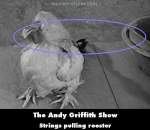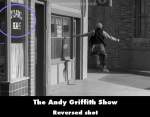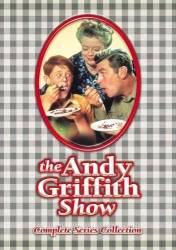My Fair Ernest T. Bass - S4-E17
Revealing mistake: At the start, when Ernest T. throws the rock at Mrs. Wiley's window and it breaks, the area around the hole flutters in the breeze - it's obviously not a glass window used for the stunt.

Aunt Bee the Crusader - S4-E15
Revealing mistake: Toward the end of the show the rooster, Bo, is drunk. If you look closely you can see the two strings pulling the rooster's neck sideways.
Revealing mistake: When Andy, Barney, Gomer, and the kids are at the campsite in the woods, during the daytime scenes the only shadows that should be seen are the ones being cast by the sun, but there are shadows being cast in different directions due to the set lighting.

Ernest T. Bass Joins the Army - S4-E3
Revealing mistake: When Barney picks Andy up and they get back to the courthouse, they find Ernest T out of the jail cell again and breaking more windows, and in the shot of Ernest T leaping in the air we see it's actually a flipped shot - note the backwards "snack bar" in the window (that store is later when Ernest T tries to break the new glass for the courthouse).
Revealing mistake: When Barney, Thelma Lou, Helen, and Andy are in the squad car talking about getting dinner, there's black tape on the chrome trim of the triangular vent window - presumably to prevent the camera/crew's reflections; and the vent window is shut in wide shots, but open in the closeup - also to prevent reflections.
Revealing mistake: Barney and Mr Weaver scuffle in the dark. When Andy enters the store he turns on the light, but the light switch is still in the off position.







Answer: As noted in the previous answers, in real life, things like this provided wind and/or rain deflection, and also maintained a bit of privacy when blinds were raised somewhat. The interior courthouse set was located in the studio, so the "outside" Main Street didn't exist. I believe these things were added to the courthouse windows for practicality, to avoid some crew movement being visible on the opposite side of those windows. These are not "window boxes" to hold anything, as they're actually bottomless; we can see the Venetian blind's long pull cords under them. They're made of plywood and simple to build, so the "material and labor" was inexpensive. Similar variations made of different materials are in other movies/shows. In 1957's "12 Angry Men," textured chicken wire glass panels are in the jury room windows, and in "Jesse Stone: Night Passage" another type is in Jesse's office windows.
Super Grover ★